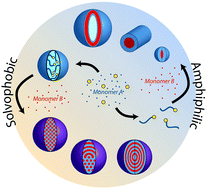Block copolymer synthesis by controlled/living radical polymerisation in heterogeneous systems
Abstract
Nanostructured soft materials open up new opportunities in material design and application, and block copolymer self-assembly is one particularly powerful phenomenon that can be exploited for their synthesis. The advent of controlled/living radical polymerisation (CLRP) has greatly simplified block copolymer synthesis, and versatility towards monomer types and polymer architectures across the different forms of CLRP has vastly expanded the range of functional materials accessible. CLRP-controlled synthesis of block copolymers has been applied in heterogeneous systems, motivated by the numerous process advantages and the position of emulsion polymerisation at the forefront of industrial latex synthesis. In addition to the inherent environmental advantages of heterogeneous routes, the incidence of block copolymer self-assembly within dispersed particles during polymerisation leads to novel nanostructured materials that offer enticing prospects for entirely new applications of block copolymers. Here, we review the range of block copolymers prepared by heterogeneous CLRP techniques, evaluate the methods applied to maximise purity of the products, and summarise the unique nanoscale morphologies resulting from in situ self-assembly, before discussing future opportunities within the field.


 Please wait while we load your content...
Please wait while we load your content...